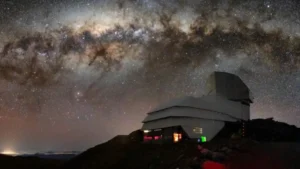Fast radio bursts (FRBs) are one of many lingering mysteries in modern astronomy. Each FRB pulse lasts mere thousandths of a second and carries as much energy as our Sun emits in a century. That is hard to fathom, for starters.
In a study released this week, researchers with the Five-hundred-meter Aperture Spherical radio Telescope (better known as FAST) in Guizhou, China, released detailed observations of a repeating FRB located at the edge of a dwarf galaxy. That distant galaxy, they estimate, resides some 3 billion lightyears from Earth. They’ve dubbed the repeater FRB 20190520B.

Optical, infrared, and radio images of the field of FRB 20190520B. Image: FAST
FRB theories & the rare repeater
What causes FRBs? One theory suggests that the bursts come about when incredibly dense matter (as in a black hole or neutron star) collides and subsequently explodes. A second theory is that FRBs result when distant stars collapse.
Thanks to FRB 20190520B’s repeated bursts, the FAST lab has been able to observe the node regularly, via telescopes around the world.
According to study author and leading FAST scientist Di Li, the project has detected more than 500 bursts since 2007. Of those 500, only 5% are repeaters. Poignantly, FRB 20190520B is just the second repeating burst that scientists have associated with a “persistent source of weaker radio waves between the pulses,” PopSci reported. Astronomers detected the other in 2012.
Echoes of the newborn universe?
For now, the majority of FRB research simply catalogs and classifies the FRBs. Li’s team hopes that this will unlock some of the many questions FRBs have inspired. These include: What drives these violent explosions? Why do some repeat, while others do not? Where in the cosmos do FRBs originate?
Li proposes another theory regarding unique, repeating, radio-emitting FRBs like 20190520B and the one detected in 2012 He says that it’s possible that both bursts behave as they do because they are younger than what seem to be singular bursts.
He compares it to fallout after an initial explosion, where debris lingers for some time before expanding out and achieving entropy. If FRB 20190520B indicates an explosion that astronomers captured in the early stages, what they see now could be the reverberations of that event.
“We live in this very dynamic universe,” Li reflected. “There are way more things in the universe that are unknown than what has already been known.”






